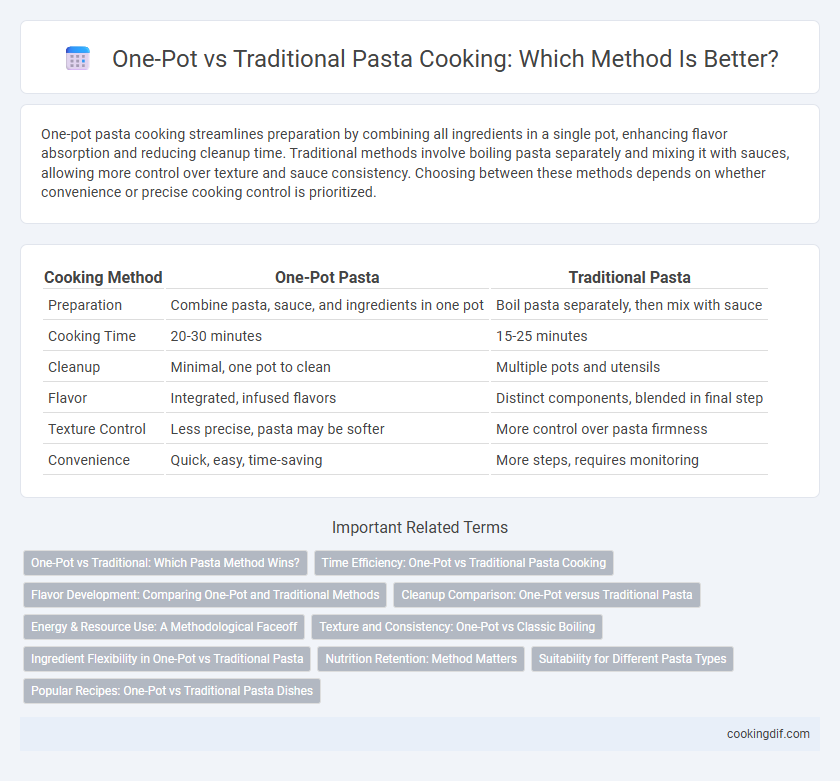One-pot pasta cooking streamlines preparation by combining all ingredients in a single pot, enhancing flavor absorption and reducing cleanup time. Traditional methods involve boiling pasta separately and mixing it with sauces, allowing more control over texture and sauce consistency. Choosing between these methods depends on whether convenience or precise cooking control is prioritized.
Table of Comparison
| Cooking Method | One-Pot Pasta | Traditional Pasta |
|---|---|---|
| Preparation | Combine pasta, sauce, and ingredients in one pot | Boil pasta separately, then mix with sauce |
| Cooking Time | 20-30 minutes | 15-25 minutes |
| Cleanup | Minimal, one pot to clean | Multiple pots and utensils |
| Flavor | Integrated, infused flavors | Distinct components, blended in final step |
| Texture Control | Less precise, pasta may be softer | More control over pasta firmness |
| Convenience | Quick, easy, time-saving | More steps, requires monitoring |
One-Pot vs Traditional: Which Pasta Method Wins?
One-pot pasta cooking saves time and reduces cleanup by combining ingredients and cooking them simultaneously, which preserves the pasta's starch and enhances sauce flavor. Traditional methods allow precise control over pasta texture and sauce consistency by boiling pasta separately and mixing it afterward, ideal for complex recipes. Choosing between one-pot and traditional methods depends on whether convenience or culinary control is the priority.
Time Efficiency: One-Pot vs Traditional Pasta Cooking
One-pot pasta cooking reduces total preparation and cleanup time by combining boiling, sauce-making, and seasoning in a single pot, significantly accelerating the process compared to traditional methods. Traditional pasta cooking requires separate boiling of pasta and simultaneous sauce preparation, which can extend overall cooking time and increase utensil usage. One-pot methods optimize heat and ingredient integration, resulting in a time-efficient approach often preferred for quick meals.
Flavor Development: Comparing One-Pot and Traditional Methods
One-pot pasta cooking enhances flavor development by allowing ingredients to simmer together, resulting in a rich, unified taste as starches and seasonings meld during the cooking process. Traditional methods, which involve boiling pasta separately before combining with sauce, preserve distinct textures but may lack the depth of flavor integration found in one-pot preparations. The simmering liquid in one-pot recipes intensifies the pasta's natural starches, creating a creamy, cohesive sauce that elevates overall flavor complexity.
Cleanup Comparison: One-Pot versus Traditional Pasta
One-pot pasta cooking significantly reduces cleanup time by using a single pot for boiling, cooking, and sauce preparation, minimizing the number of dishes and utensils required. In contrast, traditional pasta methods involve multiple pots and pans for boiling, draining, and sauce-making, resulting in more extensive washing and scrubbing. This streamlined cleanup makes one-pot pasta an ideal choice for quick, efficient meal preparation without sacrificing flavor or texture.
Energy & Resource Use: A Methodological Faceoff
One-pot pasta cooking significantly reduces energy consumption by combining boiling and simmering processes into a single integrated step, minimizing heat loss and water usage compared to traditional multi-pot methods. Traditional pasta preparation often requires multiple pots and staggered heating cycles, leading to higher water waste and increased electricity or gas expenditure. Evaluating energy efficiency, one-pot methods align with sustainable cooking practices by optimizing resource use and reducing overall environmental impact.
Texture and Consistency: One-Pot vs Classic Boiling
One-pot pasta cooking yields a creamier, starchier sauce as the pasta absorbs flavors and releases starch simultaneously, creating a cohesive dish with a softer texture. Classic boiling results in firmer, more al dente pasta due to separate cooking and draining, preserving individual noodle texture. One-pot methods offer consistent flavor integration, while traditional boiling ensures precise control over pasta firmness and bite.
Ingredient Flexibility in One-Pot vs Traditional Pasta
One-pot pasta cooking offers greater ingredient flexibility by allowing various vegetables, proteins, and seasonings to be added simultaneously, blending flavors directly in the pot. Traditional pasta methods require separate preparation and timing for ingredients, limiting real-time adjustments and complexity. The one-pot approach streamlines ingredient integration, enhancing versatile recipe variations and reducing cooking steps.
Nutrition Retention: Method Matters
One-pot pasta cooking preserves more nutrients by minimizing water usage and cooking time, reducing the leaching of water-soluble vitamins such as B and C. Traditional boiling involves draining pasta, which often results in nutrient loss through discarded water. Choosing one-pot methods enhances nutritional retention, ensuring a healthier meal with higher vitamin and mineral content.
Suitability for Different Pasta Types
One-pot pasta recipes excel with short, sturdy pasta shapes such as penne, rigatoni, and shells that cook evenly while absorbing flavors from the broth. Traditional boiling methods offer greater control for delicate pasta types like spaghetti, fettuccine, and angel hair, ensuring they maintain their ideal texture without becoming mushy. Selecting the cooking method depends on pasta shape and desired texture, with one-pot suited for heartier noodles and traditional boiling preferred for thin, fragile varieties.
Popular Recipes: One-Pot vs Traditional Pasta Dishes
One-pot pasta recipes like One-Pot Spaghetti Carbonara and One-Pot Mac and Cheese simplify cooking by combining ingredients in a single pot, reducing cleanup and saving time. Traditional pasta dishes such as Classic Fettuccine Alfredo and Bolognese sauce require draining and separate preparation of sauce, which enhances flavor complexity but increases cooking steps. Popular one-pot recipes appeal to busy home cooks seeking convenience, while traditional methods attract culinary enthusiasts prioritizing depth of taste and texture.
One-pot vs traditional for cooking method Infographic

 cookingdif.com
cookingdif.com